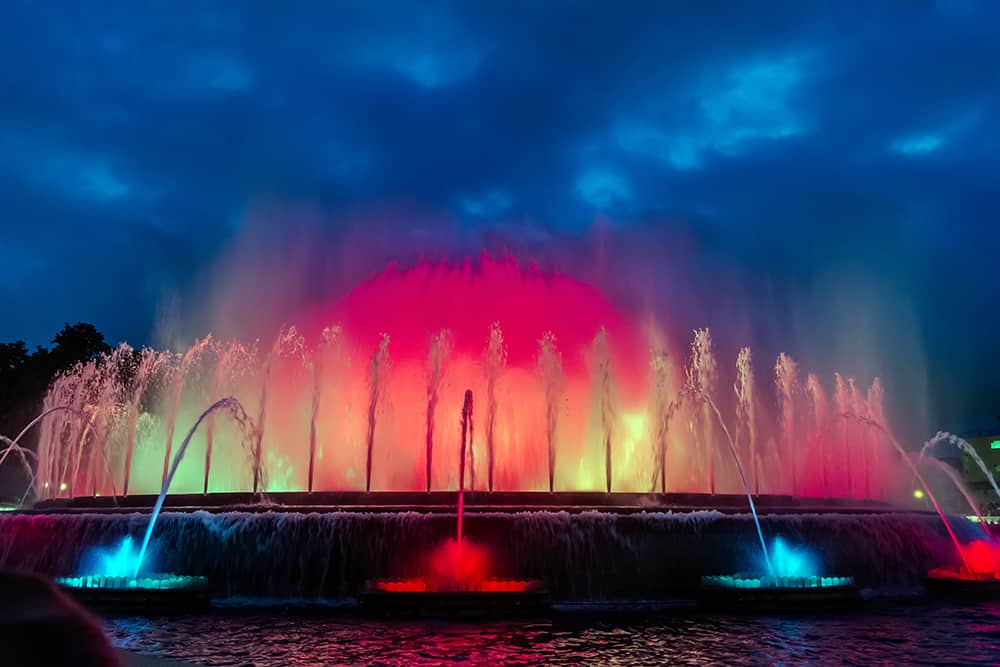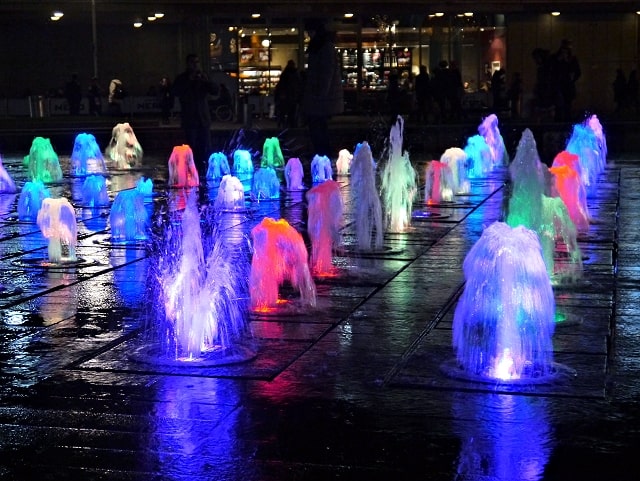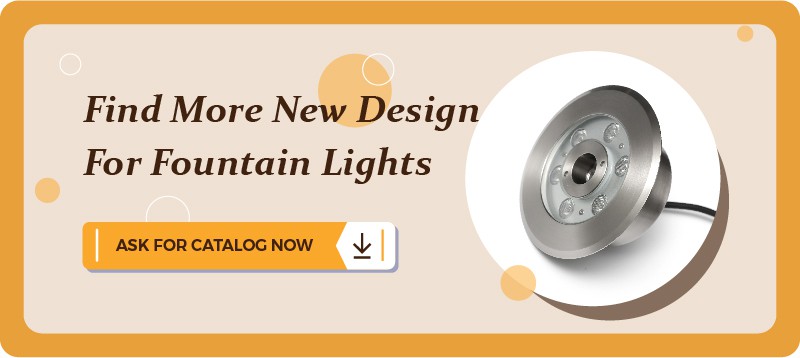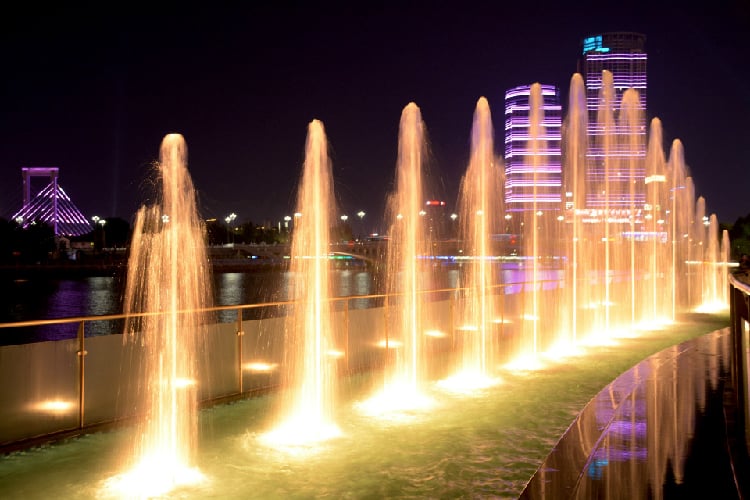In this article, you’ll find the information you need to set up fountain lights for your outdoor space. You’ll get a deeper understanding of this light fixture so you’ll know how to choose among your options. You’ll know the features you need to look for, what controls to consider, and the possibilities available when choosing the perfect fountain lights.
What Are Fountain Lights?
Fountain lights are light fixtures that illuminate the central feature of your landscape – the water fountain. The placement of these lights is usually inside the fountain. That means it’s underwater. This alone should indicate that fountain lights require specific features – like being waterproof.
For most people, a water fountain adds the perfect high-end look to any outdoor space. When you add lights to all that, the effect is multiplied.
In a survey by the American Society of Landscape Architects (ASLA), exterior lights lead in popularity among homeowners. At least, when it comes to outdoor living features. The survey reveals that 96.2% of the survey participants rated outdoor lights as a popular way to improve the external features of their properties.
This includes fountain lights. A 2015 survey by the ASLA also reveals that57% of survey respondents prefer decorative water elements in their landscape. The survey specifically includes water fountains. Since lights play an important role in turning making a water element more decorative, you’ll need to install fountain lights along with it.

What are the different types of fountain lights?
Since fountain lights are underwater, your options are not as much as other landscape lights. Among your options include the following:
- Spotlights
- Pool lights
- Recessed lights
Spotlights
Spotlights are ideal for projecting an intense and narrow beam of light. It looks like small searchlights that you can position and fixate in various directions. This makes it perfect as fountain lights. It can provide focus to highlight specific features of the water fountain.
Pool lights
Pool lights are specific for underwater installation. It’s capable of being in deep waters for a long time. Like swimming pools, the placements of these lights can be along the interior walls of the fountain or the floor area. These lights are encased in watertight housing to keep them safe.
Recessed lights
Recessed lights, as the name suggests, this is the light fixture that is built into a wall or surface. You can only see its surface. The rest of its casing is hidden within the wall or on the floor of the fountain structure. This gives it a really clean look.
2 ways to illuminate fountain lights
There are two ways you can illuminate the fountain in your outdoor space. You need to understand the difference between the two. Why? Because it’ll affect the maintenance and energy consumption of your fountain lights.
So what are the two ways you can illuminate your fountain lights?
Traditional lighting
There are two ways that traditional lighting is done.
- Incandescent lights. This type of lighting is generally based on incandescence. This means it uses lamps that have wolfram filaments. This filament is in a bulb or a glass structure that allows light to shine through. To light up, the filament conducts electricity and warms up in the process. This can generate a lot of heat that lowers the luminous efficacy. It makes the incandescent lamp consume more energy.
- Halogen lamps. The filaments of these lamps use tungsten. It’s inside a quartz ampoule that’s also full of inert and halogen gas. As fountain lights, the only halogen lamps used are either dichroic lamps or Halospot by Osram.
| ADVANTAGES | DISADVANTAGES |
| More inexpensive compared to modern lighting. The warm light it emits can reveal accurate colors of the surrounding. | It consumes more energy.It has a shorter lifespan of around 1,000 hours. |
Modern lighting
There’s only one way to implement modern lighting. It’s through the use of LED light for fountain structures. Short for Light Emitting Diode, it uses a diode as the semi-conductor. When electricity passes through it, the atoms change as the electrons and protons combine to release energy. This energy comes in the form of photons that affect the reflecting chip in the LED – leading it to produce brightness.
LED lamps are more popular than traditional lighting.
| ADVANTAGES | DISADVANTAGES |
| The absence of heat that’s common in incandescent lamps means it saves more energy. It can produce consistent luminous efficacy. It is very durable. You can turn it on and off without damaging any part. Its design allows different colors of light to be produced. | It can be costly when you compare it to traditional lighting. It can have higher transformer compatibility issues. |
Which is better: LED or Incandescent fountain lights?
Planning your fountain lights means choosing between two of the most popular options. Should you go for incandescent fountain lights or LED lights?
In the past, incandescent lights were the common option among the other traditional lights. But with the emergence of LED lights, incandescent lights became less popular over the years.
Why?
Because LED lights prove to be more durable, energy-efficient, and sustainable. Not only that, the design of LED fountain lights allows for a more flexible lighting solution. This includes changing colors, adjusting brightness, etc.
In the past, fountains were just stationary water elements outdoors. Now, landscape artists use it to create their own water and lights show. Thanks to the features of LED lights, it’s not possible to play with the lights and combine them with the movement of the water as it jets out in streams over the fountain.
What are the benefits of using underwater LED fountain lights?
Why should you use underwater LED fountain lights? In general, using fountain lights will enhance the overall design of your fountain – specifically at night. It can bring the structure to life and create the perfect mood for your outdoor area.
- Enhances movement. The light itself does not move. But the light refracts once it hits the water. This can reflect beautifully in the surrounding area – making it seem like the place is moving. If you can use colored LED lights, this can create a beautiful lights show.
- Allows you to admire the fountain despite the darkness. Imagine the darkness of the night and the way the fountain stands in the middle. The fountain lights destroy the darkness as the lights refract from the LED light source and through the water.
- Highlights the architectural beauty of the fountain. With the underwater lights being recessed in the fountain walls or flooring, all you’ll see is the structure of the fountain – and the water of course. If you position the lights correctly, the lights can reflect beautifully to highlight the architectural design of the fountain.
- Adds safety. Since these are still lights, they can add illumination to the surroundings. This can help passersby walk around without fear of falling since the light improves visibility. It can also keep people or even animals from walking into the fountain or falling into the water.
The LED underwater fountain lights also bring more benefits
The underwater LED lights are watertight, durable, and energy-efficient.
Most LED lights are watertight – making them more durable and safe to use even underwater. Usually, these have an IP68 waterproof rating. Apart from that, the design of LED lights makes them naturally durable. That means there’s no need to replace it regularly. It’s also energy-efficient – allowing you to leave the lights on for a long time without worrying about high energy costs.
Some LED lights can also deter bugs. It’s not light halogen lights that tend to attract bugs.

Different water fountain light applications
Fountain lights have different application possibilities. Architects and landscape artists use different types of fountains. This isn’t surprising since fountains have become a popular way to enhance any external area.
Each of the fountain designs offers a different way to apply fountain lights.
- Sculptural fountain. Also known as an architectural fountain, this is seen in central parts, public squares, other prominent areas of cities and villages. It often reflects the cultural history of the place through artistic designs and sculptures. The lights are there to enhance the focal point of the fountain’s design.
- Residential fountain. As the name suggests, this is for residential areas. If the residence is big enough, you might find one indoors with mini fountain lights. It’s usually smaller than what you see outdoors – which is bigger and more eye-catching.
- Floating fountain. This type of fountain literally looks like it’s floating. But the truth is, its anchor is hidden where the water flows to the ground. Fountain lights can add to the illusion.
- Water curtains. This is a different kind of water fountain. The water’s release makes it look like a screen that displays either a message or a design. This looks very modern and fountain lights have an important role in highlighting the water-screen.
- Dancing fountains. These combine the water element, incredible sound effects, and fountain lights to create a show. This uses state-of-the-art software systems to control the show and provide entertainment.
- Dry fountain. This is a playful fountain that only jets water at specific periods. This allows people to walk through it. Recessed lights are perfect for this type of fountain. It’s on the ground together with the source of water.
- Waterfalls. These can either be a water curtain or a water wall. Spotlights are perfect for highlighting this water element.
Why LED fountain lights control systems are better than traditional ones?
Fountain lights come with control systems. This makes it possible to control how the lights compliment the water element of the fountain.
There are typically two types of lighting control systems.
Traditional lights control systems
There are two types of traditional lights control systems.
The first is the adjustable intensity lamps. This is specific for incandescent and dichroic lamps. It allows you to turn the lights on and off. This system also allows adjustment of the lamp’s brilliance.
The second type is the non-adjustable lamps for fluorescent and discharge lamps. This only allows the control for turning the lights on and off. There’s no control to adjust the intensity of the light it emits.
Because of the control limitations, most architects and landscape artists no longer use the traditional lights control systems. Not only is it inefficient, but it also compromises the lifespan of the fountain lighting fixture.
LED lights control systems
Right now, architects and landscape experts prefer to use LED light control systems.
First of all, LED water fountain lights are more durable and energy-efficient. The design also makes it more flexible so you can adjust the brightness, colors, etc. There are even sophisticated control systems that allow you to time how the lights go on and off. This is perfect for fountain light shows.
There are 2 different types of LED light control systems.
| CONTROL SYSTEM | WHAT IT DOES | SPECIAL FEATURES |
| DMX Protocol | This is specific for LED lights that have a control software generating DMX signal. | Provides the most features in its electronic control system. This allows it to adjust almost all features (colors, the intensity of lights, etc) |
| RGB Controller | This device can store pre-recorded sequences that control the timing and presentation of colored lights. | Has easy programming and operational features that make it easy for non-specialized users. This requires integration with the general operative system of the fountain. |
These systems work well with LED lamps always have a control system that comes with signal adapters or drivers. It’s the driver that adjusts the voltage and current requirement.
Thanks to the capabilities of these LED lights control systems, it’s possible to program a colorful lights show for any ornamental fountain.
How to choose fountain lights for your outdoor space
When you’re choosing the right fountain lights to use in your outdoor space there are 4 steps you need to follow.
- Plan and research. Consider the effects that you want to have in your external space. There are various lighting options that you can use. It helps to light your fountain at night using a flashlight so you can get a feel of how different light angles will look like.
- Choose a special effect. Each of the lights that you can use for fountains has its respective effects. Spotlights have a higher intensity compared to recessed or underwater pool lights. Consider the effect you want to create and then choose the perfect light source for it.
- Pick a color. You don’t have to go overboard with the color. If you’re using LED lights, it’s easier to play with the colors to create even a simple light show for your fountain. Think about the mood that you want to have around the fountain. That should be a great way to start choosing colors.
- Think about the placement. What is the size of the fountain and how bright do you want it to be at night? While you can always dim the lights, you want to make sure that you’ll only install what’s necessary. The placement also includes the wiring of the fixtures. Ensure that everything will be out of sight and it won’t endanger people from tripping on anything in the dark.
When you’re planning the fountain lights, you have to make sure that you consider the neighboring areas. This is especially true if the fountain will be in a residential area. You don’t want it to be too bright at night.
What colors are commonly used for fountain lights?
Combining fountain lights with the movement of the water is already very impressive. But if you want a more artistic and creative show, why not add some color to it? If you’re going to follow the popular trend of using LED lights to illuminate fountains, adding colors is easier.
Why? Because the design of LED fountain lights makes it easier to incorporate new color schemes.
With every LED fountain light allowing flexibility when it comes to color temperatures, it’s easier to achieve the mood that you want for your external area. Whether you want the fountain to be soothing or mysterious, the color of the lights that you’ll choose can help you achieve it.
While you can mix various colors in your fountain, it’s always a good idea to have a color theme. Here are the three common colors of lights used for fountains.
White lights
This is the default color option for most fountain lights. It can either be stark or eggshell white. This is the perfect option if you want to present a clean environment. However, you have to be careful when using this color. It’s very easy to make it too bright. When that happens, the lights might distract viewers or passersby from the overall look and structure of the fountain.
Remember, the fountain has a water element in it. So when the white light reflects on the surface of the water, it might be too bright. It could also be distracting if the fountain has steel or metal elements in it where the light can reflect even further.
Make sure your LED fountain lights underwater come with controls so you can adjust the brightness as you see fit.
Blue hues
Blue hues can perfectly complement the aquatic element of the fountain. The popular shades for fountains include deep blue, blue-green, light blue, and sometimes, even indigo. Just be careful when mixing darker shades of blue with your background and the material of the fountain.
What makes blue quite popular is the calming effect that it has. Not only that, blue can help people focus and think. So if your fountain is there to enhance the peace and serenity of your outdoor space, using shades of blue as your fountain lights is a perfect choice.
Orange shades
If you want to be a bit bolder in your fountain light color choice, use orange. You have the option to use neon, dark or red-orange light. You can also use gold lights.
By choosing this color, you’re promoting energy in your outdoor space. It’s the perfect lighting solution if your fountain is in the midst of an events area. So that when a get-together or party happens at night, there’s enough illumination to add fuel to the mood of the event.
This is also great for keeping the people around the fountain alert. It’s not as overwhelming or bright as white lights but it’s enough to illuminate an entire area.
Frequently asked questions about fountain lights
Here are frequently asked questions about fountain lights.
What’s the best way to illuminate a fountain?
More architects and landscape artists prefer to use LED fountain lights. Why? Because it’s more durable and energy-efficient. Remember, fountain lights are usually on for hours. This means the lights should have a long lifespan and won’t consume a lot of energy.
Since LED lights won’t consume a lot of energy, they won’t heat up the way other types of lights would. This makes it very safe. Not only that, the lack of heat won’t compromise the brightness that the LED lights will emit.
What is the right angle for fountain lights?
There’s an easy way to determine the right angle of the fountain lights. Make sure that the lights won’t overpower the fountain itself. After all, the fountain is the main feature. That means you should position the lights so it highlights the structure and important features of the fountain.
You should also avoid angling the lights so it reflects too much. This can be distracting and at times – irritating to look at.
Make sure you consider the common viewing area of the fountain. This is usually the front or any seating area near it. People will stand here to view the fountain. Angle the fountain lights away from these areas so they won’t directly hit the viewing positions.
What are the qualities of a great fountain light?
First of all, a fountain light should be durable enough to last for a long time. Replacing fountain lights can be tricky. This is why the best light that you should use are LED lights.
Since there’s a water element here, you should look for waterproof lights for fountain structures. These submersible fountain lights should have at least an IP68 rating. This means it can be used or even submerged underwater.
You should also get fountain lights that have an easy-to-use control system. It’s not just to help you adjust the brightness. It should also allow you to manipulate the colors of the lights if you wish.
Where’s the best place to position fountain lights?
This would depend on the overall design of the fountain. You should also consider the hardware of the light fixture. Fountains lights should be hidden so only the lights are visible.
Maintenance should also be a consideration. Make sure the lights are easily reachable for cleaning and maintenance purposes.
What’s the best location for fountain spotlights?
These fountain lights are best positions from high up. You can place spotlights in nearby structures. That way, the lights won’t be calling attention to themselves. It’s easier to hide them. The focus will solely be on the fountain itself. With the right positioning, the lights can reflect on the water beautifully.
Where should you install submersible fountain lights?
When installing submersible fountain lights, make sure it provides enough illumination from under the water. After all, the light will have to pass through the water.
You should also consider the position of the underwater fountain lights. Make sure it can provide even lighting throughout the fountain’s surface.
You have to consider the fact that submersible lights might be vulnerable to corrosion – specifically around the seal. That means you should install it where you can replace it easily.
How many fountain lights should be installed?
Putting too many outdoor fountain lights might give off too much glare. The brightness might overshadow the fountain. Not only that, the bright light might be too blinding for people – making them less likely to look and appreciate the beauty of the fountain.
It’s best to consider the mood that you want to achieve. It can influence how many lights you’ll need to make that ambiance happen.
Do you need professional help to install fountain lights?
This depends on your capabilities and experience in installing lights. Ideally, it’s best to leave the installation to professionals. Remember, fountain lights are usually underwater. There’s less room for error when you install it. The fountain lights should be watertight. You also want to make sure the hardware and the wire of the lights will not be visible.
Why choose fountain lights from RC Lighting?
RC Lighting is an ISO9001-certified manufacturer of fountain lights for many years. You can expect high-quality materials and durable lighting solutions. All the fountain lights go through strict testing procedures all the time. You can also talk to our capable team about unique designs and lighting requirements. They can also help with the installation of the fountain lights – to ensure the right application and safety.







